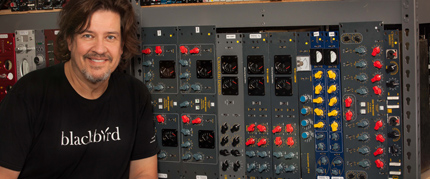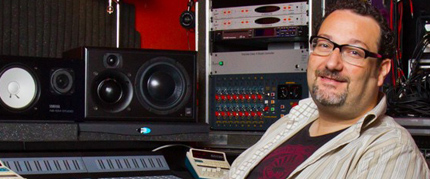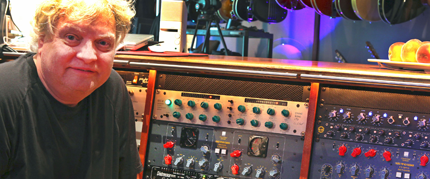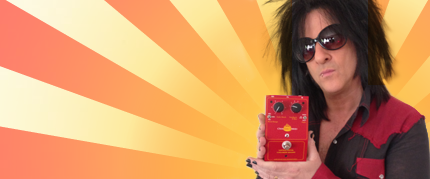Chandler Limited
Germanium Mic Pre Amp
by: Mike Caffrey
Have you noticed how some manufacturers consistently hit home runs with their gear designs? I think there are lots of things that manufacturers with this success rate have in common: high standards, good design and manufacturing discipline and the designer is usually the owner of the company without the financial restraints put on them by a marketing department. In my opinion, Chandler is one of these manufacturers. Another thing I associate with Chandler is flavors of gear that no one else is making, such as the EMI inspired line and the only rack mixer and summing box with transformers on every input channel as well as the stereo out. In continuing that trend, the Chandler Germanium mic preamp incorporates a few key design features that, as far as I know, no other manufacturers do. And it is a very cool sounding preamp.
The first key feature is that the transistors are germanium rather than silicon. This is the same germanium that you might be familiar with from guitar overdrive pedals. Germanium transistors were used in the EMI TG12345 preamps, the earliest Neve preamps (such as the 1057), and some of the early Telefunken and Fairchild designs. While the 1057 was used as a reference during the design stage, the Chandler Germanium is not a clone.
Germanium transistors are desirable for their sonic properties, often described as smooth, round, and organic. They tend to distort in a pleasant manner and are less brittle sounding than silicon transistors. The drawbacks are that germanium transistors are temperamental, hard to work on, and they can be very noisy. With a lot of trial and error testing--and once a good source for high-tolerance germanium transistors was found--Chandler managed to make the Germanium their quietest mic preamp yet. It also ended up with the highest headroom of any Chandler preamp. It clips at +34 dBu, which is much higher than the input of any current digital converter. (In comparison, the 1057 clips at +22 dBu).
The second key feature is the Feedback knob in place of a standard output knob. In general, negative feedback works by taking a little bit of the signal at the output and subtracting it from the signal at the input--the primary effects being reduced distortion, flatter frequency response, and lower output impedance. Secondary effects include increased damping factor, reduced volume, and a more sudden transition from clean to distorted. On the Germanium, as you turn the Feedback knob clockwise, you’re increasing the feedback series-resistance and therefore decreasing the amount of negative feedback. Less negative feedback means more total output, more second-harmonic distortion, less highs, and a low-end bump at 30 Hz. In use, the Feedback knob functions as a texture control. Setting the Feedback knob in a low position makes the signal more linear, giving it a tighter, more defined sound--similar to the pristine clarity heard on a well-made digital recording. With the Feedback knob in a higher position (with less feedback), the sound gets smoother in a very pleasing way that’s hard to describe. I could “feel” it while playing a bass through the Germanium; the reduced feedback had a very nice effect on my playing.
How does it sound? In two words: shizzly dizzly! (That means great for those without the 2005 edition of the Hipster Dictionary). It has its own tone. If you use Neve and API as common reference points, I’d say that it can sound like both depending on how you set the Feedback. With the knob in the 9 o’clock to 11 o’clock range, it has that punchy fast slew-rate vibe of the API. When you turn it up, it’s more of the classic Neve vibe. However, throughout all this, its fundamental tone is big and round. (Keep in mind these are reference terms. You’re not actually changing the slew rate.)
My first session use with the Germanium was on vocals. I used an RE20 (for its rejection capabilities) to cut vocals in the control room with the monitors up. I followed the Germanium with a compressor and didn’t need EQ. The tone was beautiful and inviting. Overall, the project was recorded and mixed really well, but the most common feedback (no pun intended) I got from listeners was how nice the vocal sound was and how “well recorded” the vocals were. I can’t say that it was only due to the preamp, but I have a pretty specific approach to what I do with rock vocals, and this was the only variable that I had changed.
From there, I experimented with a ’69 P-Bass. The Germanium is equipped with a switch labeled Thick that adds a gentle rise in the low-end, but I didn’t need that feature at all. With that in, the sound was just too fat. I started playing with the Feedback control, and it quickly became clear how it changed the tone. But more significantly, it changed my playing. At first I thought it was my imagination. I found that with the Feedback knob turned clockwise, I’d get totally lost in my playing and forget about testing. I was playing with more effective touch and more balanced dynamics, and I’d end up playing cool things that I wouldn’t normally play. [Um… Mike, what did you bring back from Amsterdam? – AH] When I turned the Feedback knob counterclockwise, that feeling would go away. Just to be sure, I forced myself to play the exact same thing the exact same way with both settings, and that made it very clear how it was changing the texture of the tone. The less feedback (the “higher” the knob), the softer and more pleasing the sound. It wasn’t soft in a lack of punch sense. It just felt less stark and like it was compressed slightly--which, if it’s adding second harmonic distortion, makes sense.
From there, I tried it on guitars, using a Beyerdynamic M 160. I compensated for the ribbon’s darkness by running the Germanium into a TG Channel MKII for some EQ. The result was amazing. The sound was rich and very colorful (as opposed to how sometimes things sound black and white--I don’t know how else to describe it. Feedback had the same effect on texture as it did on bass, and I found I liked the knob set high to smooth out clean tones and a little lower for distorted tones. Doubling with two different Feedback settings could be a nice way to provide some contrast between the two performances.
On guitar, the Thick switch was amazing. My first impression was that it was a low boost, but I was monitoring with a subwoofer, and somehow, with this big thick bump, it didn’t add a lot of low end mud. It had an effect on the midrange as well, making it denser. I found myself using the Thick switch most of the time for guitars and also when recording snare drums. I had great results on a Rhodes, but it was torture deciding whether I liked the Feedback up or down.
After starting to think of the preamp as a “texture designer” as well as a signal amplifier, I decided to try running the stereo buss through a pair. Again, it really sounded great. We had been listening to a really nice sounding monitor mix all night while tracking to tape. I engaged the Germanium’s pad switches and ran the mix through with Feedback knob all the way up, and I immediately noticed that more colorful vibe. Putting the Thick switch in gave the mix a boost of power. When I switched back to the original, I was surprised at how bland it sounded, especially considering how happy we’d been with it all night. I tried the same thing again after we transferred through RADAR Nyquist converters into Pro Tools. Running mixes through the Germanium helped make up for the little bit of depth and openness that was lost as a result of the analog to digital transfer. I’m not intending to say that it sounds like tape, but the preamp’s natural tone and “texture designer” capabilities had a really nice effect on the mix of the digital tracks. I found myself liking aspects of both texture options--Feedback up and Feedback down.
Overall, I think the Germanium is a really great preamp, and it stands out from the crowd because of its unique design and its many sonic possibilities. I lean towards using it with the Feedback knob up because I don’t have anything else--nor have heard anything else--that sounds like that. I’m very curious what it would sound like to track en entire song just with Germanium preamp with the Feedback knob all the way up, except for an individual track or two (like vocals) that you want to highlight in the mix (i.e., make the track stick out with the definition that you get with the Feedback control set low rather than with volume or EQ). I also like the fact that the Germanium has uses beyond a mic preamp. With its great sound, design, and versatility, and a street price of $1050, I think it will quickly become a staple in all ranges of studios.
—Mike Caffrey, www.monsterisland.com
















